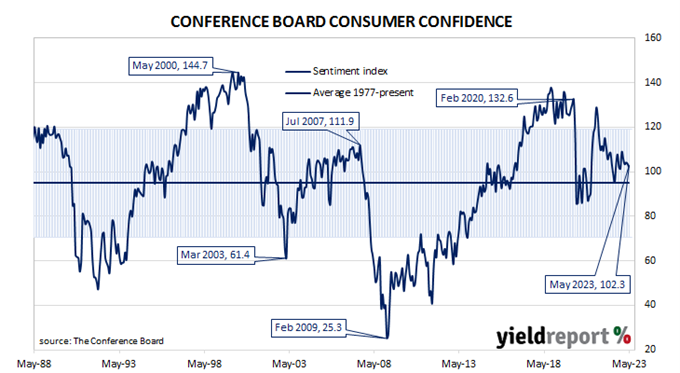Summary: Conference Board Consumer Confidence Index falls in May, reading more than expected; notable worsening in outlook among older consumers; NAB: report details reveal bearish picture; views of present conditions, short-term outlook deteriorate.
US consumer confidence clawed its way back to neutral over the five years after the GFC in 2008/2009 and then went from strength to strength until late 2018. Measures of consumer confidence then oscillated within a relatively narrow band at historically high levels until they plunged in early 2020. Subsequent readings then fluctuated around the long-term average until March 2021 when they returned to elevated levels. However, a noticeable gap has since emerged between the two most-widely followed surveys.
The latest Conference Board survey held during the first three weeks of May indicated US consumer confidence has deteriorated. May’s Consumer Confidence Index registered 101.3 on a preliminary basis, above the generally-expected figure of 99.0 but below April’s final figure of 103.7. “While consumer confidence has fallen across all age and income categories over the past three months, May’s decline reflects a particularly notable worsening in the outlook among consumers over 55 years of age,” said Ataman Ozyildirim, a senior director of economics at The Conference Board.
US Treasury yields moved substantially lower on the day, especially at the short end of the curve. By the close of business, the 2-year Treasury bond yield had shed 15bps to 4.46%, the 10-year yield had lost 8bps to 3.56% while the 30-year yield finished 4bps lower at 3.89%.
In terms of US Fed policy, expectations of lower federal funds rates in 2024 firmed. At the close of business, contracts implied the effective federal funds rate would average 5.17% in June, 9bps higher than the current spot rate, and then move up to average 5.26% in July. September futures contracts implied a 5.32% average effective federal funds rate while May 2024 contracts implied 4.355%, 74bps less than the current rate.
“US consumer confidence fell to a six-month low with details in the report also revealing a bearish picture, the Conference Board business expectations index fell to its lowest reading since 2011 while the share of consumers who said jobs were plentiful fell to the lowest level in more than two years,” noted NAB currency strategist Rodrigo Catril.
Consumers’ views of present conditions and of the near-future both deteriorated. The Present Situation Index decreased from April’s revised figure of 151.8 to 148.6 while the Expectations Index declined from 71.7 to 71.5.
The Consumer Confidence Survey is one of two widely followed monthly US consumer sentiment surveys which produce sentiment indices. The Conference Board’s index is based on perceptions of current business and employment conditions, as well as respondents’ expectations of conditions six months in the future. The other survey, conducted by the University of Michigan, is similar and it is used to produce an Index of Consumer Sentiment. That survey differs in that it does not ask respondents explicitly about their views of the labour market and it also includes some longer-term questions.



